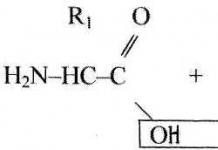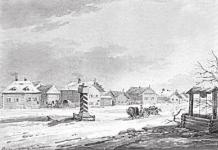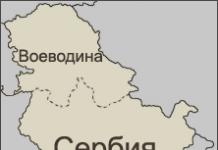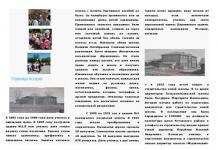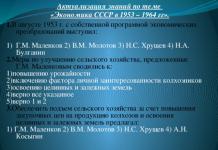Calculus of infinitesimals and large
Infinitesimal calculus- calculations performed with infinitesimal values, in which the derived result is considered as an infinite sum of infinitesimal ones. Infinitesimal calculus is general concept for differential and integral calculus, which form the basis of modern higher mathematics. The concept of an infinitesimal quantity is closely related to the concept of a limit.
Infinitesimal
Subsequence a n called infinitesimal, if . For example, a sequence of numbers is infinitely small.
The function is called infinitesimal in a neighborhood of a point x 0 if ![]() .
.
The function is called infinitesimal at infinity, if ![]() or
or ![]() .
.
Also infinitely small is a function that is the difference between a function and its limit, that is, if ![]() , then f(x) − a = α( x)
, .
, then f(x) − a = α( x)
, .
infinitely large
In all the formulas below, infinity to the right of equality implies a certain sign (either "plus" or "minus"). That is, for example, the function x sin x, unbounded on both sides, is not infinitely large for .
Subsequence a n called infinitely large, if ![]() .
.
The function is called infinitely large in a neighborhood of a point x 0 if ![]() .
.
The function is called infinitely large at infinity, if ![]() or
or ![]() .
.
Properties of infinitesimals and infinitesimals
Comparison of infinitesimals
How to compare infinitesimal quantities?
The ratio of infinitesimal quantities forms the so-called uncertainty.
Definitions
Suppose we have infinitely small for the same value α( x) and β( x) (or, which is not important for the definition, infinitesimal sequences).
To calculate such limits, it is convenient to use L'Hospital's rule.
Comparison examples
Using O-symbols of the results obtained can be written in the following form x 5 = o(x 3). In this case, the entries 2x 2 + 6x = O(x) and x = O(2x 2 + 6x).Equivalent quantities
Definition
If , then infinitesimal quantities α and β are called equivalent ().
Obviously, equivalent quantities are a special case of infinitesimal quantities of the same order of smallness.
For , the following equivalence relations hold (as a consequence of the so-called remarkable limits):
Theorem
The limit of the quotient (ratio) of two infinitesimal quantities will not change if one of them (or both) is replaced by an equivalent value.This theorem is of practical importance in finding limits (see example).
Usage example
Replacing sin 2x equivalent value 2 x, we getHistorical outline
The concept of "infinitely small" was discussed in ancient times in connection with the concept of indivisible atoms, but did not enter classical mathematics. Again, it was revived with the advent in the 16th century of the "method of indivisibles" - the division of the figure under study into infinitesimal sections.
The algebraization of the infinitesimal calculus took place in the 17th century. They began to be defined as numerical values that are less than any finite (non-zero) value and yet not equal to zero. The art of analysis consisted in drawing up a relation containing infinitesimals (differentials), and then in integrating it.
Old school mathematicians subjected the concept infinitesimal harsh criticism. Michel Rolle wrote that the new calculus is " set of brilliant mistakes»; Voltaire pointed out venomously that this calculus is the art of calculating and accurately measuring things whose existence cannot be proven. Even Huygens admitted that he did not understand the meaning of higher-order differentials.
As an irony of fate, one can consider the appearance in the middle of the century of non-standard analysis, which proved that the original point of view - the actual infinitesimals - is also consistent and could be taken as the basis for analysis.
see also
Wikimedia Foundation. 2010 .
See what "Infinitesimal" is in other dictionaries:
INFINITELY SMALL- a variable in some process, if in this process it infinitely approaches (tends) to zero ... Great Polytechnic Encyclopedia
infinitesimal- ■ Something unknown, but related to homeopathy... Lexicon of Common Truths
Uniqueness of the limit and boundedness of a convergent numerical sequence
Definition 1 . A numerical sequence (1) is called bounded if the set of members of this sequence forms a bounded set.
In this case, we will call the numerical sequence (1) limited value.
Definition 2 . The numerical sequence (1) converges and has a limit (It is possible to use the notation ) if .
Let's repeat this definition, using more of the Russian language. The limit of a numerical sequence exists and is equal to a certain number if, starting from a certain number, all members of the sequence are less than any given, arbitrarily small positive number, from this limit number. The same can be said in other words. The number will be the limit of the numerical sequence (1) if and only if for each -neighborhood of the point all members of the sequence, starting from some number, lie in this -neighborhood. Note that the interval is called the -neighborhood of the point .
Theorem 1 . If the limit of a numerical sequence exists, then it is unique.
Proof
. Let us prove the theorem by the "method by contradiction". Suppose that the theorem is false and there are at least 2 numbers and () for which the conditions of Definition 2 are satisfied. In this definition, we take . Then, after the number, the members of the sequence differ from the number by less than , and after the number, the members of the sequence differ from the number by less than . Let us show that this cannot be. In fact, at ![]() the relations , , are satisfied, whence for these we have . The theorem has been proven.
the relations , , are satisfied, whence for these we have . The theorem has been proven.
Theorem 2 . If a number sequence has a limit, then that number sequence is bounded.
Proof . The proof will be constructive. Let's take and find the appropriate . Let's split the sequence into 2 parts: the first members and the remaining members of the sequence. The first group consists of a finite number of members and is therefore limited. The second group consists of numbers that are no more than 1 away from the limit value, and therefore is also limited. The union of two bounded sets is a bounded set. The theorem has been proven.
Infinitely small quantities and their properties
Definition 3 . The number sequence is called infinitely small if it has a limit equal to 0.
For infinitesimal quantities, the notation is used b. m.
Let numerical sequences and be given. A numerical sequence with a common term is called the sum of these number sequences. A numeric sequence with a common term , is called the sum of these numeric sequences. A numeric sequence with a common term , is called the sum of these numeric sequences.
Theorem 3 . The sum of a finite number of infinitesimal quantities is an infinitesimal quantity.
Proof
. It suffices to prove the assertion for the sum of two b. m. Let the numerical sequences and be infinitesimal quantities, i.e., the limits of these sequences are equal to 0. This fact means the following. If an arbitrary scrollingly small positive number is given, then for the number and the numerical sequence there exists a number that has the property that for . For the same reason, for the same number and number sequence, there exists a number that has the property that, for , the relation holds. Let's take a number ![]() , then for
, then for ![]() . So, for an arbitrary we have found a number such that when . Therefore, the limit of the sequence , is equal to 0, and it is an infinitesimal quantity. The theorem has been proven.
. So, for an arbitrary we have found a number such that when . Therefore, the limit of the sequence , is equal to 0, and it is an infinitesimal quantity. The theorem has been proven.
Theorem 4 . The product of an infinitesimal quantity by a limited quantity is an infinitesimal quantity.
Proof
. Let the numerical sequence be an infinitesimal value, and the numerical sequence be a bounded value. This means that, on the one hand, , on the other hand, there is a number such that the condition is satisfied for each. Now let an arbitrary, scrollingly small positive number be given. Consider the number , for it in the numerical sequence there is a number , which has the property that the relation holds for . In this case, the condition ![]() , which means that the product of these two quantities - infinitesimal and limited - is an infinitesimal quantity. The theorem has been proven.
, which means that the product of these two quantities - infinitesimal and limited - is an infinitesimal quantity. The theorem has been proven.
Limit Properties
And how exactly is the calculation of limits, in this case, numerical sequences? We try to represent the value, the limit of which must be found, as a sum, difference, product, quotient of simpler quantities, the limit of which is easy to find. To justify such an approach, it is necessary to formulate and prove the properties of the limits.
Theorem 5 . A number sequence has a limit equal to if and only if the sequence , is an infinitesimal value.
Proof
. Let , i.e. for each for , the inequality () is satisfied. But this inequality is tantamount to Besides that ![]() , i.e., the sequence , has a limit of 0, i.e., is an infinitesimal quantity. The theorem has been proven. , where - b. m. It follows that . In the last parenthesis, the sum of two infinitesimal quantities is the quantity b. m. Therefore, it is represented as a sum and an infinitesimal value. By virtue of Theorem 5, this means that
, i.e., the sequence , has a limit of 0, i.e., is an infinitesimal quantity. The theorem has been proven. , where - b. m. It follows that . In the last parenthesis, the sum of two infinitesimal quantities is the quantity b. m. Therefore, it is represented as a sum and an infinitesimal value. By virtue of Theorem 5, this means that ![]() . The first assertion of the theorem is proved. Formula
. The first assertion of the theorem is proved. Formula ![]() is proved in exactly the same way. Consider now the formula
is proved in exactly the same way. Consider now the formula ![]() and use the same notation to transform the left side. That's why …
and use the same notation to transform the left side. That's why …
The concept of infinitesimal and infinitely large quantities plays an important role in mathematical analysis. Many problems are simply and easily solved using the concepts of infinitely large and small quantities.
infinitesimal.
A variable is called infinitesimal if for any there is such a value that each value following it will be less in absolute value.
If - infinitesimal then they say that it tends to zero, and they write:
infinitely large.
Variable x called infinitely large if for every positive number c there is a value such that each following it x will be larger in absolute value. Write:
The reciprocal of infinitely large, there is a quantity infinitesimal, and back.
10. Properties of function limits
1) Constant value limit
The limit of a constant value is equal to the constant value itself:
2) Amount limit
The limit of the sum of two functions is equal to the sum of the limits of these functions:
Similarly, the limit of the difference of two functions is equal to the difference of the limits of these functions.
Extended sum limit property:
The limit of the sum of several functions is equal to the sum of the limits of these functions:
Similarly, the limit of the difference of several functions is equal to the difference of the limits of these functions.
3) Limit of the product of a function by a constant value
The constant coefficient can be taken out of the limit sign:
![]()
4) product limit
The limit of the product of two functions is equal to the product of the limits of these functions:
Extended product limit property
The limit of a product of several functions is equal to the product of the limits of these functions:
5) quotient limit
The limit of the quotient of two functions is equal to the ratio of the limits of these functions, provided that the limit of the denominator is not equal to zero:

11. First wonderful limit
![]()
Proof

Consider one-sided limits and and prove that they are equal to 1.
Let be . Let's put this angle on the unit circle ().
Dot K- the point of intersection of the ray with the circle, and the point L- with a tangent to the unit circle at the point . Dot H- point projection K per axle OX.
It's obvious that:
(where is the area of the sector)
![]()
Substituting into (1), we get:
![]()
Since at:
![]()
We multiply by:
![]()
Let's go to the limit:
![]()
![]()
![]()
Let's find the left one-sided limit:
The right and left one-sided limits exist and are equal to 1, which means that the limit itself is equal to 1.
12-13. The second wonderful limit
![]() or
or ![]()
Proof of the second remarkable limit:
Knowing that the second remarkable limit is true for natural values of x, we prove the second remarkable limit for real x, that is, we prove that ![]() . Consider two cases:
. Consider two cases:
1. Let . Each x value is enclosed between two positive integers: , where is the integer part of x.
It follows from this: therefore
If , then . Therefore, according to the limit ![]() , we have:
, we have:
On the basis (on the limit of an intermediate function) of the existence of limits ![]() .
.
2. Let . Let's make a substitution, then
From these two cases it follows that ![]() for real X
for real X
14. Partial derivatives.
Let be z=f(x,y) . Fix any point (x,y), and then, without changing the fixed value of the argument y, give the argument x increment . Then z will receive an increment called a partial increment z on x and is denoted and defined by the formula .
Similarly, if x keeps a constant value, and y gets incremented, then z receives a private increment z on y,.
Definition. Partial derivative with respect to x from function z=f(x,y) is called the limit of the ratio of partial increment in x to an increment when tending to zero, i.e.
The partial derivative is denoted by one of the symbols ![]() .
.
The partial derivative with respect to y:
![]() .
.
Thus, the partial derivatives of a function of two variables are calculated according to the same rules as the derivatives of a function of one variable.
Example. Find Partial Derivatives of Functions z=x 2 e x-2y .

The partial derivatives of a function of any number of variables are defined similarly.
Comparison of infinitesimal functions, equivalent functions
Infinitely small and infinitely large quantities.
O.1. The sequence is called infinitely large if for any positive number A (no matter how large we take it) there is a number N such that for n>N the inequality | x n | > And those. whatever big number But we didn’t take it, there is such a number, starting from which all members of the sequence will be greater than A.
Definition 6. The sequence (α p ) is called infinitely small if for any positive number ε (no matter how small we take it) there is a number N such that the inequality | α p | ‹ε.
1. The sequence (n) is infinitely large.
2. The sequence () is infinitesimal.
Theorem 1. If (x p) is an infinitely large sequence and all its members are non-zero, x p ≠0, then the sequence (α p) \u003d is infinitesimal, and, conversely, if (α p) is an infinitely small sequence, α p ≠0 , then the sequence (x n )=infinitely large.
Let us formulate the main properties of infinitesimal sequences in the form of theorems.
Theorem 2. The sum and difference of two infinitesimal sequences are infinitesimal sequences.
Example 2 A sequence with a common term is infinitesimal, because i.e., the given sequence is the sum of infinitesimal sequences and, therefore, is infinitesimal.
Consequence. The algebraic sum of any finite number of infinitesimal sequences is an infinitesimal sequence.
Theorem 3. The product of two infinitesimal sequences is an infinitesimal sequence.
Consequence. The product of any finite number of infinitesimal sequences is an infinitesimal sequence.
Comment. The quotient of two infinitesimal sequences can be any sequence and may not make sense.
For example, if , , then all elements of the sequence are equal to 1 and this sequence is bounded. If , , then the sequence is infinitely large, and vice versa, if , and , then is an infinitely small sequence. If starting from some number the elements of the sequence are equal to zero, then the sequence does not make sense.
Theorem 4. The product of a bounded sequence and an infinitesimal one is an infinitesimal sequence.
Example 3 The sequence is infinitesimal, because and the sequence () is infinitesimal, the sequence is bounded, because ‹ 1. Therefore, is an infinitesimal sequence.
Consequence. The product of an infinitesimal sequence by a number is an infinitesimal sequence.
Definition. The function f(x) is called infinitely large for , if for any, even arbitrarily large positive number , there is such a positive number (depending on М, δ=δ(М)), that for all x not equal to x 0 and satisfying the condition , the inequality
Write down: or at.
For example, a function is an infinitely large function for ; function at .
If f(x) tends to infinity at and takes only positive values, then write if only negative values, then .
Definition. The function f(x) given on the whole number line is called infinitely large for , if for any positive number , there is such a positive number (depending on М, N=N(М)) that for all х satisfying the condition , the inequality
For example, the function y \u003d 2 x is an infinitely large function for ; the function is an infinitely large function for .
Properties of infinitely large functions:
1. Product b.b.f. for a function whose limit is nonzero, there is a b.b.f.
2. Sum b.b.f. and a bounded function is a b.b.f.
3. The quotient of division of the b.b.f. for a function that has a limit, there is a b.b.f.
For example, if the function f(x)=tgx is a b.b.f. at , the function φ(х)=4х-3 at has a non-zero limit (2π-3), and the function ψ(х)=sinx is a bounded function, then
f(x) φ(x)=(4x-3) tgx; f(x) + ψ(x)= tgx + sinx; there are infinitely large functions for .
Definition. The function f(x) is called infinitesimal at , if
By definition of the function limit, equality (1) means: for any, even arbitrarily small positive number , there is such a positive number (depending on ε, δ=δ(ε)), that for all x not equal to x 0 and satisfying the condition , the inequality
Theorem. To fulfill the equality, it is necessary and sufficient that the function be infinitesimal at . In this case, the function can be represented as .
The b.m.f. is defined similarly. for ,- 0, , in all cases f(x)0.
Infinitely small functions are often called infinitesimals or infinitesimals; denote usually Greek lettersα, β etc.
For example, y=x 2 at x→0; y=x-2 at x→2; y=sinx at х→πк, are infinitely small functions.
Properties of infinitesimal functions:
1. The sum of a finite number of infinitesimal functions is an infinitesimal quantity;
2. The product of a finite number of infinitely small functions, as well as an infinitely small function on limited function, is an infinitesimal quantity;
3. The quotient of dividing an infinitesimal function by a function whose limit is not equal to zero if the value is infinitesimal.
Consider the last property for if the functions and are infinitesimal (Comparison of infinitesimal functions):
one). If , then is called infinitesimal, more high order smallness than .
Example. At x→2, the function (x - 2) 3 is infinitely small of a higher order than (x -2), since .
2). If , then and are called infinitesimals of the same order (they have the same rate of tending to zero);
Example. At x→0, the functions 5x 2 and x 2 are infinitesimal of the same order, since .
3). If , then and are called equivalent infinitesimal, denoted by ~., then
Relationship between infinitesimal and infinitely large functions: the inverse function of an infinitesimal is infinitely large (and vice versa), i.e. if - infinite small function, then is infinitely large.
The definition of an infinitesimal sequence is given. It has the properties of convergent sequences. There are also properties that are characteristic only for sequences with a limit equal to zero. Proofs of such properties are given. An example is considered in which it is necessary to prove that the sequence is infinitesimal.
ContentDefinition
Infinitesimal sequence (αn) is a convergent sequence whose limit is zero:.
The following properties are a direct consequence of the arithmetic properties, applied to sequences whose limit is zero.
The property of the sum and difference of infinitesimal sequences
Sum and Difference finite number of infinitesimal sequences is an infinitesimal sequence.
Also a linear combination of a finite number of infinitesimal sequences is an infinitesimal sequence.
Proof of the limit of the sum and difference of numerical sequences.
Product property of infinitesimal sequences
Product of a finite number infinitesimal sequences is an infinitesimal sequence.
Proof of the Limit of the Product of Number Sequences.
The following properties apply only to infinitesimal sequences and are not a direct consequence of the properties of convergent sequences.
( x n )
x n \u003d b + α n,
where (αn)
Property Proofs
Property of the product of a bounded sequence by an infinitesimal
Product of a bounded sequence to an infinitesimal is an infinitesimal sequence.
Proof
Let the sequence be limited by some number :
(3.1)
.
Let the sequence be infinitesimal. That is, there is such a function depending on the variable that for any positive value of the variable , the inequality
(3.2)
at .
Let the sequence be the product of the sequences and . Its general term is:
.
We need to find a function that satisfies the inequality
(3.3)
at .
We apply (3.1) and (3.2):
.
This is done with . So,
.
Let's put :
.
That is, we have found such a function , under which, for any positive number , the following inequality is true:
(3.3)
at .
The property has been proven.
The property of representing a convergent sequence in terms of an infinitesimal
In order for the sequence ( x n ) has a limit b , it is necessary and sufficient that
x n \u003d b + α n,
where (αn) is an infinitesimal sequence.
Proof
Necessity. Let be . Consider a sequence with a common term . We use the arithmetic properties of limits:
.
That is, an infinitesimal sequence.
Adequacy. Let be . Based on the arithmetic properties of limits, we have:
.
The property has been proven.
Example
All examples Using the definition of the limit of a sequence, prove that the sequence
is infinitely small.
We write the definition of an infinitesimal sequence:
.
Since n is a natural number, n = 1, 2, 3, ...
, then
,
,
.
Therefore, the terms of the sequence are positive numbers. Then
.
So, we got the following score:
.
Enter positive numbers and :
.
According to the properties of inequalities , if and , then
.
It follows that for any positive one can find natural number, so at ,
.
This means that the limit of the original sequence is zero and, therefore, it is infinitesimal.


